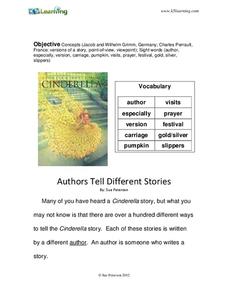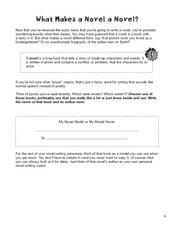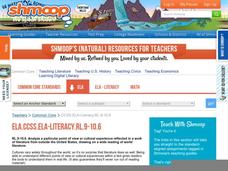K12 Reader
Change the Point of View: First Person and Third Person
How is a story different when told from various points of view? Learn about first and third person points of view with an activity based on Robert Louis Stevenson's Treasure Island. Readers examine a passage written in first person, then...
K12 Reader
Point of View: Who Is Telling the Story?
See how famous books of literature have different perspectives with a short worksheet. After reviewing the difference between first and third person points of view, learners look over six passages from various novels and decide which...
Curated OER
Third-Person Limited, Omniscient or Objective Point of View?
Help your readers identify different points of view by studying key words the author uses to mold the story. There are four story excerpts provided here, and readers must identify the point of view, record the words that led them to that...
Manchester College
What’s Your Point of View?
Work on deciphering the point of view of various pieces of literature. As readers review the concepts of first, second, and third person perspective, they apply what they know to different passages.
Curated OER
Marking Time
Two narrative excerpts tell the same story from different points of view. In the first excerpt (first person), sequencing words and phrases are bolded and learners write down what the bold type does. The second excerpt is in third...
Library of Congress
Determining Point of View: Paul Revere and the Boston Massacre
If you're teaching point of view, this is the lesson for you! First, decipher the writer's point of view from a primary resource, then compare and contrast the primary source with a secondary source to explore the Paul Revere's engraving...
Road to Grammar
Fame
Smile for the camera and find out how your English language learners feel about fame! Class members read three different points of view on fame and then discuss ten questions about the topic.
Learning Station
Point of View—Picking Favorites
For this writing learning exercise, learners discover how a story can change depending on the point of view the writer has chosen. Students read several excerpts from stories and respond in writing to how they are different.
English Linx
Points of View Worksheet
Scholars need to learn as early as possible the different types of point of view, because one cannot speak in the second person for his entire life—it would be very rude. This covers first, second, and third person. The examples are...
Curated OER
Literary Element: Point of View
In this literacy worksheet, students focus upon the element of literature know as the point of view. They use the story and discuss the first and third person context.
Curated OER
Views of Shapes
In this math learning exercise, students examine the two and three dimensional shapes. They use the observations in order to define the different points of view.
Curated OER
What's the Context Worksheet
What is context? The class researches a family treasure carefully for its hidden significance as well as its obvious story. They interview family members to gain more insight and context clues to determine point of view and meaning...
Fluence Learning
Writing About Informational Text: Beyond the Beyond—Galaxies
Everyone has a different point of view, even when it comes to the enormity of the universe. Two separate text passages explain the scope of a galaxy, prompting young readers to write an essay about each author's argument and how the...
Curated OER
Of Mice and Men: Viewing Guide
In this Of Mice and Men viewing guide worksheet, young scholars study movie terminology as they read brief descriptions and respond to 26 short answer questions as the watch the film based on Steinbeck's novel.
K5 Learning
Authors Tell Different Stories
The story of Cinderella is a popular one! So much so, there are multiple versions of the story being told around the world. With this collection of activities your young readers receive background information about two versions...
Curated OER
What Makes a Novel a Novel?
As your authors prepare to write a hypothetical novel, they need all the inspiration they can find! Using a book they have already read (and enjoyed), learners complete a literary analysis by filling in eight short-answer questions....
Syracuse City School District
Literary Elements
Address the literary elements in a piece of writing using these materials. The packet includes plenty of resources, and focuses mainly on theme, character, and point of view, with some materials for setting, symbolism, and author's...
Mr. Mansour
Ralph S. Mouse by Beverly Cleary
Take an in-depth look into Beverly Cleary's story, Ralph S. Mouse, with a 10-question learning exercise that focuses on story elements. Scholars describe the main character, point of view, conflict resolution, and more! Then, conclude...
K5 Learning
The Blind Men and the Elephant
Sometimes it's necessary to view the whole picture before making a judgment about a small part. Read a short story about five blind men who try to identify an elephant by feeling different parts and coming to their own conclusions....
Super Teacher Worksheets
The Closet Creature
Kelly Hashway's "The Closet Creature" gives primary graders an opportunity to demonstrate their reading comprehension skills as they respond to the prompts on four different reading worksheets.
K12 Reader
Different Perspectives: The American Revolution
Prompt your young historians to hone in their reading comprehension skills by considering the fascinating perspective that Rudyard Kipling offers in his poem, "The American Rebellion", which provides an alternative perspective toward the...
Mathed Up!
Nets, Plans, and Elevations
A dimensional resource teaches viewers to recognize 2-D views of 3-D objects and how to match nets with their 3-D figures. Individuals draw different views of three-dimensional objects including views from the front, side elevations and...
Houghton Mifflin Harcourt
El Bronx Remembered
Use a worksheet to cover different types of conflicts from El Bronx Remembered, a series of short stories by Nicholasa Mohr. The questions address "A Very Special Pet," "Shoes for Hector," "Mr. Mendelsohn," "A Lesson in Fortune-Telling,"...
Shmoop
ELA.CCSS.ELA-Literacy.RL.9-10.6
Being able to identify and understand the point of view of fictional characters across a wide range of time periods, places, and cultures is a skill that is necessary for becoming a proficient reader. It is also a skill identified in the...

























